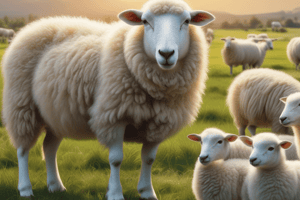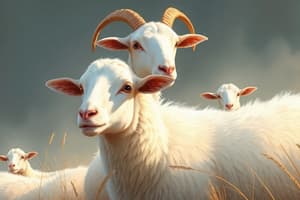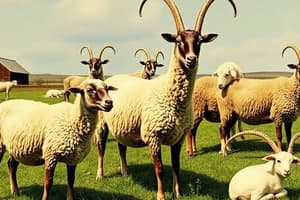Podcast
Questions and Answers
Sheep and goat farming are affected by climatic conditions, geographical conditions, pasture or rangeland condition, and quality of ________
Sheep and goat farming are affected by climatic conditions, geographical conditions, pasture or rangeland condition, and quality of ________
pasture
The breeding purposes of the breed can be for meat, milk, dual-, or multi-________
The breeding purposes of the breed can be for meat, milk, dual-, or multi-________
purposes
Marketing opportunities consider the marketing possibilities of the products obtained from small ________
Marketing opportunities consider the marketing possibilities of the products obtained from small ________
ruminants
Different production systems are applied based on the conditions of countries and regions within the ________
Different production systems are applied based on the conditions of countries and regions within the ________
Sheep and goat production systems can be classified in terms of management practices and year-round mobility of ________
Sheep and goat production systems can be classified in terms of management practices and year-round mobility of ________
Extensive production is one of the management practices characterized by high reliance on natural ________
Extensive production is one of the management practices characterized by high reliance on natural ________
The country with the most number of goats in 2017 was ______
The country with the most number of goats in 2017 was ______
The maximum total between 1980-2017 in terms of sheep meat was in ______
The maximum total between 1980-2017 in terms of sheep meat was in ______
The top country in 2017 for goat meat production was ______
The top country in 2017 for goat meat production was ______
In terms of red meat production, the share of cattle was highest in ______
In terms of red meat production, the share of cattle was highest in ______
The country with the second most number of goats in 2017 was ______
The country with the second most number of goats in 2017 was ______
The country with the third most number of goats in 2017 was ______
The country with the third most number of goats in 2017 was ______
In places where pastures are very insufficient, especially goats can also be fed with plant residues, tree branches and leaves; In harsh and snowy winters, the native goats can even use oak and pine leaves and willow shoots as ______.
In places where pastures are very insufficient, especially goats can also be fed with plant residues, tree branches and leaves; In harsh and snowy winters, the native goats can even use oak and pine leaves and willow shoots as ______.
Sheep and goats can utilize the vegetation that cattle cannot benefit from. Goats can benefit from tree branches as ______.
Sheep and goats can utilize the vegetation that cattle cannot benefit from. Goats can benefit from tree branches as ______.
Sheep and goats can make good use of areas where crop production is not possible. Thus, sheep and goat breeding is the most important source of income for the people in places with unimproved agriculture and limited feed ______.
Sheep and goats can make good use of areas where crop production is not possible. Thus, sheep and goat breeding is the most important source of income for the people in places with unimproved agriculture and limited feed ______.
Sheep and goats also have the ability to utilize the usable land after harvesting ______ lands (post-harvest fields).
Sheep and goats also have the ability to utilize the usable land after harvesting ______ lands (post-harvest fields).
On the other hand, intensive sheep breeding and goat breeding are carried out with dairy sheep, goat breeds and meat sheep breeds in regions with high quality ______.
On the other hand, intensive sheep breeding and goat breeding are carried out with dairy sheep, goat breeds and meat sheep breeds in regions with high quality ______.
Native sheep and goats are resistant to adverse environmental conditions and insufficient nutrition. In addition, it is more resistant to conditions such as cold, heat, hunger and thirst compared to other farm ______.
Native sheep and goats are resistant to adverse environmental conditions and insufficient nutrition. In addition, it is more resistant to conditions such as cold, heat, hunger and thirst compared to other farm ______.
Semi-intensive production system allows sheep and goat to graze for 6-10 hours in rangeland/pastureland and further requirements are met through supplementation of concentrate feed. Local resources, crop byproducts, and lopping from plants are utilized in a better way in this ________ system.
Semi-intensive production system allows sheep and goat to graze for 6-10 hours in rangeland/pastureland and further requirements are met through supplementation of concentrate feed. Local resources, crop byproducts, and lopping from plants are utilized in a better way in this ________ system.
Semi-intensive production system is less expensive as cohesive production is done as compared to ________ production system.
Semi-intensive production system is less expensive as cohesive production is done as compared to ________ production system.
Sedentary system is common in sheep and goat raising in the World and in ________.
Sedentary system is common in sheep and goat raising in the World and in ________.
In sedentary system, sheep and goat flocks are kept at or close to the village or farm all the year round. During the day they are grazed either on the common village range or on privately-owned or hired grazing areas; they also have access to stubbles and fallow fields. For the night they return to their sheds in the village or on the farm. These flocks are shepherded all the time during ________.
In sedentary system, sheep and goat flocks are kept at or close to the village or farm all the year round. During the day they are grazed either on the common village range or on privately-owned or hired grazing areas; they also have access to stubbles and fallow fields. For the night they return to their sheds in the village or on the farm. These flocks are shepherded all the time during ________.
Sedentary flocks are wintered in the sheds for 1–5 months depending on the region and severity of the climatic conditions. In this system, intensive and semi-intensive production is generally applied, and extensive production is applied less ________.
Sedentary flocks are wintered in the sheds for 1–5 months depending on the region and severity of the climatic conditions. In this system, intensive and semi-intensive production is generally applied, and extensive production is applied less ________.
The production performance of many native sheep/goat breeds evaluated under semi-intensive system were observed satisfactory performance. Small Ruminants Production Systems include sedentary system and ________ system.
The production performance of many native sheep/goat breeds evaluated under semi-intensive system were observed satisfactory performance. Small Ruminants Production Systems include sedentary system and ________ system.
Village flocks managed under this System may consist of 200–300 sheep or goats; number of animals in private farm flocks vary between 50 and 300. Household sheep and goat keeping in the villages and towns may also be considered within this System (Smallscale or Family enterprises).These family flocks may consist of 2–5 sheep or goats of milk type. They graze the vegetation in the gardens and around the nearby crop fields. Small Ruminants Production Systems 2.
Village flocks managed under this System may consist of 200–300 sheep or goats; number of animals in private farm flocks vary between 50 and 300. Household sheep and goat keeping in the villages and towns may also be considered within this System (Smallscale or Family enterprises).These family flocks may consist of 2–5 sheep or goats of milk type. They graze the vegetation in the gardens and around the nearby crop fields. Small Ruminants Production Systems 2.
The traditional transhumant System of sheep and goat production is still common in the World and in Turkey (especially in the mountainous Mediterranean, Black Sea and Eastern Anatolian regions). In this system, extensive production is generally applied, and semi-intensive production is applied less frequently.______ sheep and goat flocks move out of the hotter and drier lowland areas in the end of spring to graze on the better and cooler grazing areas of highlands and plateaus. After remaining there for 4–5 months, they return to their base villages or farms in autumn, where they are fed or grazed through following spring. The grazing areas on highlands and plateaus are in general state property. Those belonging to private persons are rented by flock owners for grazing.
The traditional transhumant System of sheep and goat production is still common in the World and in Turkey (especially in the mountainous Mediterranean, Black Sea and Eastern Anatolian regions). In this system, extensive production is generally applied, and semi-intensive production is applied less frequently.______ sheep and goat flocks move out of the hotter and drier lowland areas in the end of spring to graze on the better and cooler grazing areas of highlands and plateaus. After remaining there for 4–5 months, they return to their base villages or farms in autumn, where they are fed or grazed through following spring. The grazing areas on highlands and plateaus are in general state property. Those belonging to private persons are rented by flock owners for grazing.
Flocks may be private or communal, i.e.owned by different persons. The transport of the animals to the summer grazing areas is either by walking or by ______.
Flocks may be private or communal, i.e.owned by different persons. The transport of the animals to the summer grazing areas is either by walking or by ______.
The grazing areas on highlands and plateaus are in general state ______.
The grazing areas on highlands and plateaus are in general state ______.
Household sheep and goat keeping in the villages and towns may also be considered within this System (Smallscale or Family enterprises). These family flocks may consist of 2–5 sheep or goats of ______ type.
Household sheep and goat keeping in the villages and towns may also be considered within this System (Smallscale or Family enterprises). These family flocks may consist of 2–5 sheep or goats of ______ type.
After remaining there for 4–5 months, they return to their base villages or farms in autumn, where they are fed or grazed through following ______.
After remaining there for 4–5 months, they return to their base villages or farms in autumn, where they are fed or grazed through following ______.
Flashcards are hidden until you start studying
Study Notes
Sheep and Goat Farming
- Farming is influenced by climatic and geographical conditions, pasture quality, and breed characteristics.
- Breeding purposes include meat, milk, dual-purpose, or multi-purpose uses.
Marketing and Production Systems
- Marketing opportunities hinge on products derived from small ruminants.
- Different production systems apply based on regional conditions and practices.
- Production systems are classified by management practices and seasonal mobility of livestock.
Extensive vs Intensive Production
- Extensive production relies heavily on natural resources and less on supplemental feeding.
- Intensive breeding emphasizes high-quality dairy and meat production.
- Native breeds exhibit resilience to extreme environmental conditions, including drought and harsh winters.
Global Goat Statistics
- In 2017, China had the highest goat population, with India and Nigeria following as the second and third highest, respectively.
- Top goat meat production in 2017 was led by China.
- Sheep meat production peaked in 2017, with significant total production noted between 1980-2017.
Feeding Practices
- In areas with insufficient pasture, goats can forage on plant residues, tree branches, and leaves.
- Goats are advantageous as they can utilize vegetation unaccessible to cattle, thriving in crop fields post-harvest.
Small Ruminants Production Systems
- Two main production systems: sedentary and traditional transhumant.
- Sedentary systems involve keeping flocks close to villages with daily grazing.
- Transhumant systems involve seasonal migration from lowlands to highland grazing areas, typically lasting 4–5 months.
Grazing Management
- Transhumant flocks are moved to cooler areas post-spring, utilizing state-owned or rented private lands.
- Household flocks in villages typically range from 2-5 animals, focusing on sustainability and local resources.
- Seasonal grazing patterns allow for recovery of pasture areas and proper livestock management.
Economic Impact
- Sheep and goat breeding serves as a critical income source for communities with limited agricultural resources.
- Production performance in semi-intensive systems has shown satisfactory outcomes for many native breeds.
Studying That Suits You
Use AI to generate personalized quizzes and flashcards to suit your learning preferences.




